![]() Prices in Canadian Dollars.
Prices in Canadian Dollars.![]() Prefer to call and speak to a floral agent? 1-877-277-4787
Prefer to call and speak to a floral agent? 1-877-277-4787
Fillers And Other Flowers
Information on Fillers & Other Flowers
Quick Links
Agapanthus
Pronunciation: ag-ah-pan-thus
Species Name: Agapanthus Africans
Description: Spectacular funnel shaped florets in a round cluster that is 4 – 6″ across. This is a true focal flower with strong, single stems which are available in blue with stems of 30 – 39″ and white with stems of 20 – 24″. In the United States, Agapanthus are sometimes called African Lily or Lily Of The Nile. With proper care, Agapanthus have a vase life of 5 – 7 days.
Aster
Species Name: Callistephus chinensis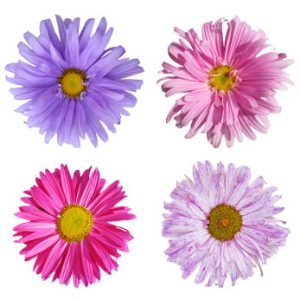
In Greek aster means Star, for its star-like blossoms. Legend says that Aster was created when the goddess Asteria looked down at earth from the heavens and wept because she could not see any stars. Aster bloomed where her tears fell. There are numerous species within the Aster family. Each Aster variety consists of multiple branches with numerous small flowers on lateral stems, and flowers have a vase life of 6 – 7 days. The flowers are small and have a thin petal texture, therefore blooms dry out if left out of water for extended periods of time.
Common Varieties:
Monte Casino:
White flowers with yellow centers (like tiny, fragile Daisies)
Novi-Belgii:
Varieties available with petals in shades of pink, lavender, white and light blue – all with yellow centers (like tiny, fragile Daisies – similar to Universum varieties)
Solidago:
Florets available in shades of yellow (similar to Solidaster varieties but with fuller, bushier florets)
Universum:
Varieties available with petals inshades of lavender and white – all with yellow centers (like tiny, fragile Daisies – similar to Novi-belgii varieties)
Design Suggestions:
Vibrant colours provide contrast in designs. Aster mixes well with Poms, Mini Carnations and Carnations Use as an accent flower in arrangements.
Bird Of Paradise
Species Name: Strelitzia reginae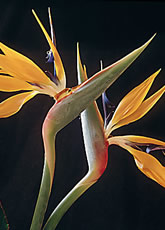
This species is named after actualBirds-Of-Paradise, a beautiful bird with brightly coloured plumage and a fan- like tail. This exotic, orange, purple and dark blue tropical flower is a member of the banana family and is well known for its characteristic, bird-like appearance. Several flowers in a sheath-like, pointed pod (bract) open sequentially. The bloom size is usually 4 – 6″ long and provides a dramatic display. This focal flower works easily with all types of tropical and some summer flowers, and has a vase life of 8 – 10 days.
Bouvardia
Pronunciation: boo-var-dee-ah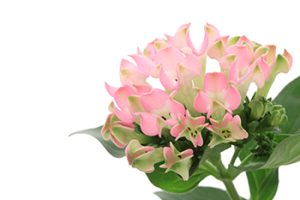
Species Name: Bouvardia longiflora
These flowers are also called Kangaroo Paws because of the appearance of the closed flower blooms. Description: Tubular, star-like florets form a cluster blossom at the end of thin, sometimes woody stems. The flowers have a light fragrance and mainly come in pink, orange, red and white. Blooms can be double in some pink and white varieties. Bouvardia also features attractive bright green foliage that is elliptical in shape. With proper care the vase life can be 14 – 20 days.
Calla Lilies
Pronunciation: kal-la li-lees
Species Name: Zantedeschia aethiopica, Zantedeschia elliotiana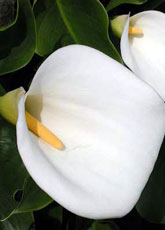
Description: A thick, waxy spathe(petal) wraps around this elegant “less-is-more” flower. Large white Callas are well known, but smaller, coloured Callas are becoming more familiar. Either can provide the focal point for a spectacular arrangement or bouquet. Vase life for both varieties ranges between 5 – 7 days.
Design Suggestions: Callas are very fashionable. One to three stems of white Callas in a vase make a strong statement. A clear vase with clear marbles is especially elegant. Coloured Callas are appealing in bunches or in a mixed, monochromatic bouquet with other specialty flowers.
Daffodils
Pronunciation: DAF-o-dills
The daffodil is also called Narcissus.  In Greek mythology, Narcissus fell in love with his own reflection. He was turned into a flower, to nod into the water at his reflection forever. The Daffodil is a trumpet-shaped flower with a central corolla and surrounding petals. The traditional Daffodil is solid yellow, but many variations include yellow with an orange center, white with an orange center, white with a yellow center and solid white. Flowers should arrive in the “pencil” or “goose neck” stage, when buds are no longer upright and slightly open with colour showing. Daffodils open very quickly and have a short vase-life of 4 – 8 days.
In Greek mythology, Narcissus fell in love with his own reflection. He was turned into a flower, to nod into the water at his reflection forever. The Daffodil is a trumpet-shaped flower with a central corolla and surrounding petals. The traditional Daffodil is solid yellow, but many variations include yellow with an orange center, white with an orange center, white with a yellow center and solid white. Flowers should arrive in the “pencil” or “goose neck” stage, when buds are no longer upright and slightly open with colour showing. Daffodils open very quickly and have a short vase-life of 4 – 8 days.
Delphinium
Pronunciation: del-fin-ee-um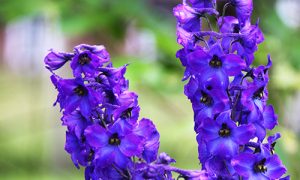
The name is derived from the Greek word for dolphin because of the resemblance of the flower spurs (partly opened buds) to a dolphin’s head. It is also said that the Greeks named this flower after Delphinium Apollo, the god of the city of Delphi. The flower spikes of Delphinium bloom from bottom to top with cup-shaped blossoms which are 1/4 – 1/2″ in diameter. Dark blue Bellamosum Delphinium and light blue Belladonna Delphinium are “sisters” to other varieties in the delphinium family – available in colours that range from white to light and dark blues, violet, red or pink. Another common Delphinium hybrid is Larkspur. These flowers are 1″ across, arranged on a long spike measuring 8 – 24″ in length. There are also branching types with several flower spikes on one plant. Stems could be as long as 100 cm. Flowers are available in a variety of different colours.
Design Suggestions: Delphinium’s unique blue colour is excellent for holiday bouquets and arrangements. Has an “old fashioned” appeal that blends well with most other flowers. Mix with roses and Queen Anne’s Lace for an elegant, Victorian appearance.
Freesia
Pronunciation: free-zhee-uh
Species Name: Iridacceae
This flower is named after Germanbotanist Friedrich H. T. Freese. He was a pupil of Dr. Christian P. Ecklon who named this genus for Freese. Slender, wiry stems have combs of richly scented, tubular flowers. Both single and double flowering varieties are grown in bright shades of white, yellow, lavender, red, pink, mauve, violet or purple. Anywhere from 6 – 9 flowers stand upright on stalks that emerge from only one side of 9 – 18″ long stems. Freesia can last 10 – 14 days in a vase.
Bulbflowers have a tendency to drink more water than they need and thus open too quickly. By placing flowers in very little water (only 1 1/2 – 2″ deep), you can slow down the opening process and thus prolong vase life. Brilliant colours brighten up any display, and their fragrance is highly noticeable – especially when placed in warmer rooms where the heat brings out the fragrance.
Gerbera Daisies
Pronunciation: ger-ber-uh DAY-zees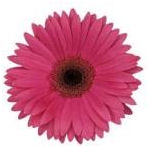
Named after Truagott Gerber, a German botanist and naturalist who traveled extensively in Russia and wrote an important monograph on Russian specimens. Also called Transvaal Daisy, it is a single stem flower that resembles a daisy in shape – with a round centre surrounded by flat petals. Centres can be fancy (double form, with small fluffy petals) or basic (single form or traditional type, with flat centres). The centre is usually a contrasting colour to the surrounding petals which range in colour from white to vibrant red, pink, yellow, salmon, orange and magenta with white or black centers. Flowers have an average vase-life of 7 – 12 days.
Design Suggestions: Display a small number of stems in straight edged, clear vase for a dramatic, modern look. Fill vase with colour coordinated marbles for added effect.
Gladioli
Pronunciation: Plural – Gladioli; gla-dee-oh-lee (Singular – Gladiolus; gla-dee-oh-lus )
Species Name: Gladiolus grandiflorus
As to the name, think of it as in”gladiator”, because of its sword-shaped leaves, derived from a Latin word meaning little sword. Gladiolus species were recognized over 2,000 years ago growing in the fields of Asia Minor and were called “corn lilies”. They began being used as cut flowers in North America in the early 1800s, developed from European hybrids. Today, there are at least 180 known species. The impressive flower spikes of Gladioli come in a wide array of beautiful colours. Long, thick stems display individual funnel-shaped blossoms which range from 2 – 5″ in diameter and all face the same direction. Common names include Glads and Sword Lilies, which refer to its leaves which are long, thin and pointed. With proper care and handling, Gladioli have a vase life of 10 – 14 days (depending on the room temperature and the sunlight).
Godetia
Pronunciation: go-DEE-sha
Also known as Satin Flower or SilkFlower, Godetia has a funnel or trumpet shaped flower consisting of four petals that are arranged on a terminal spike. There are single and double forms in shades of pale pink, orange red and violet/pink. Flowers measure approximately 3″ across. When set in a vase tight cut, closed flower buds will open.
Gypsophila
Pronunciation: jip-sof-i-la
Species Name: Gypsophila paniculata
Commonly called Gyp or Baby’s Breath(because of its small, softly-scented blossoms), this species originated in the Mediterranean and eastern Europe. Many tiny flowers are produced in massive quantities on slender, multi-branched stems giving a lacy, snowflake appearance. The small grayish-green leaves are barely noticeable below masses of flowers. Flowers are usually white, although a few pink varieties are sometimes available. The most common varieties are Perfecta and Bristol Fairy. The botanical name Gypsophila means love chalk – referring to its preference for chalky soil.
Design Suggestions: Use as a filler flower in bouquets and arrangements, creating depth and dimension. Use Gyp in Victorian-style arrangements. Dries well and is excellent for dried arrangements. Simply hang upside down for a few days.
Heather

Theseevergreen shrubs consist of tight stems covered with tiny leaves. They have 6- to 10-inch flower spikes and come in purple, lavender, pink and white. Heather is a flowering plant or cut flower.
Iris
Pronunciation: eye-ris
Species Name: Iridaceae
Originating in the Mediterranean region and southern Europe, the Iris was considered a symbol of power by the ancient Egyptians. The Greeks named it after Iris, their goddess of the rainbow. The Fleur-de-Lis (a stylized Iris motif) has symbolized France since the 13th century. Bulbous plants that have sword-shaped leaves and flowers composed of six petals in various colours (blue, yellow, purple and white). The three upright petals are called Standards and the three that hang down are called Falls. Flowers have a relatively short vase life of 2 – 5 days which can be maximized with proper use of flower food.
Bulb flowers have a tendency to drink more water than they need and thus open too quickly. By placing flowers in very little water (only 1 1/2 – 2″ deep), you can slow down the opening process and thus prolong vase life. Be sure to replenish preservative solution daily.
Liatris
Pronunciation: lee-aht-ris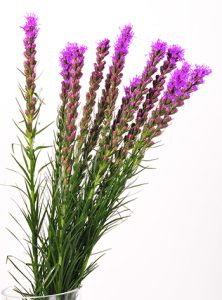
Species Name: Liatris callilepis, Liatris spicata
Common names for Liatris include:Purple Poker, Kansas Gay Feather, Button Snakeroot or Blazing Star. The petals on these tall, narrow fluffy spikes open from the top down giving a bottle-brush type of appearance. Flowers have a vase life of 6 – 7 days. Its long inflorescence (flower spike) comes in violet tones and its thick stems offer versatility in use. Foliage is dark green and grass-like, and stems are strong and woody.
Lilies
Pronunciation: li-lees
Species Name: Asiatic Lilies – Lilium hybridum, Oriental Lilies – Lilium speciosium
Throughout the ages, the Lily has stood for purity and sweetness, modesty, whiteness and fragility. Various species are widely referenced in Greek mythology. Asiatic (Hybrid) Lilies: The elegant, six-petaled blooms of Asiatic Lilies are cup-shaped with re-curved tips, and are usually upright on the stem. Blooms vary in size from 2 – 4″ and include a wide range of both solids and bi- colours with flecks of brush mark colouration in the throat. Stem lengths are in the range of 40 – 130 cm.
Oriental Lilies: Oriental Liliesare the largest of the Lily family, ranging between 6 – 10″ in diameter. Also cup- shaped with re-curved petals, the fragrant blooms hang to the side of stem (pendant) rather than stand upright. The Orientals come in a smaller variety of colours – from pristine white (Casablanca) to a rosy-hued, bi-colour pink (Star Gazer). The stems are generally taller than the Asiatics with stem lengths of 60 cm or more. The average vase life of a stem of lilies is 14 – 20 days. Individual blooms generally last 4 – 5 days and should be removed from stems when they are no longer attractive.
Bulb flowers have a tendency to drink more water than they need and thus open too quickly. By placing flowers in very little water (only 1 1/2 – 2″ deep), you can slow down the opening process and thus prolong vase life. Be sure to replenish preservative solution daily.
For use in designs, remove anthers as buds open to prevent accidental staining from pollen. If you get lily pollen on your clothing, use a dry toothbrush, chenille stem or dry towel to brush off. Do not brush off with your hands as this rubs pollen deeper into fabric.
Limonium
Pronunciation: le-MOE-nee-uhm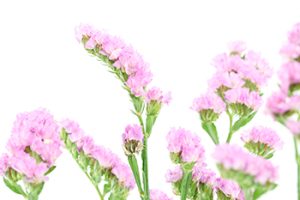
This is an ancient Greek name probablyderived from the word for meadow. Limonium is a large classification of flowers that covers numerous different varieties. The Misty Blue variety of Limonium is grown on bushes with long, narrow, multi-branching stems featuring clusters of very tiny flowers at the end of each lateral. As a general rule, it is not shipped with any foliage however, a fine lacy foliage may periodically appear on the woody stems. Similar varieties have flowers in shades of pink and white. This product dries very well – recommended for use in dried arrangements.
Orchids
Pronunciation: or-kids
Orchids are tropical flowering plants that thrive in rain forests. Flowers are available in shades of white, yellow, pink, rose and orange or combinations of these colors with purple and black flecks.
Cattleya Orchid: (KAT-lee-a)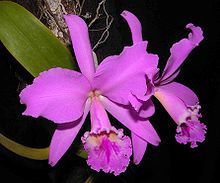
Flamboyant, epiphytic flowers, composed of three colourful sepals, two large side petals and a flared lip. Available in white, yellow and shades of lavender or rosy pink. Flowers are 3 – 5″ across. At one time it was the most popular of the Florists’ Orchids – and is still the traditional corsage Orchid.
Cymbidium Orchid: (sim-BID-ee-um)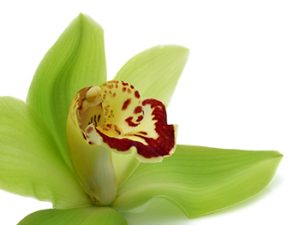
The 70 plus species of Cymbidium comefrom Asia. The generic name comes from the Greek, “kymbe; boat-shaped cup,” and refers to the shape of the lip. The tremendous number of hybrids provide a beautiful range of color around the calendar
Spray Orchids occurring in white and shades of brown, mauve, yellow and green with a rose or pink lip. Often has 15 – 20 blooms per stem which are 3 – 4″ across. Named for its boat-like lip.
Dendrobium Orchid: (den-droh-bee-um) 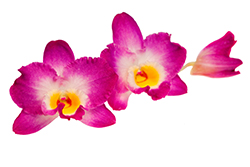
There are over a thousand knownspecies of Dendrobium and still more are being discovered, a member of the Orchidaceae family. Most species of this popular flower originated in Asia and the South Pacific region. The dendrobium name, made up of the Greek words dendron, which means, “tree,” and bios, which means “life,” alludes to where the plant is often seen growing. Also known as the Singapore Orchid. Sprays of 10-12 dainty flowers on slender stems, often like daffodils in shape. Dendrobium orchids used to be considered exotic and extravagant but in recent years they have become much more widely available. They ooze glamour and elegance, with just a couple of stems adding a sophisticated touch to a room.
Queen Anne’s Lace
Species Name: Ammi majus
Description: Queen Anne’s Lace has made a big comeback in popularity in the past few years. It tints well (immersion) and should be cut on the green side (40% open), otherwise it will drop little white specks everywhere once the florets fully open.
Snapdragons
Species Name: Antirrhinum majus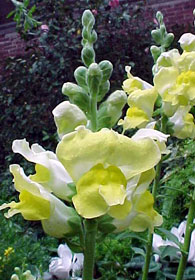
So named because of its snout-like blossoms. A light pressure on either side of a single blossom will make the “jaws” of the dragon open. The species name “Antirrhinum” is the Greek translation for “like a nose”. Snapdragons are called Rabbit’s Lips in Asia, and Lion’s Lips in Holland. Snapdragon blossoms are approximately 1 1/2″ long and tubular in shape with rounded upper and lower lips. Approximately 10 – 15 flowers appear on each flower spike, opening from the bottom up. A fantastic range of colours include: white, yellow, orange, several pinks, red, bronze, maroon, lavender, apricot and many bi-colours. Snapdragons have a vase life of up to 14 days in flower preservative.
Statice
Species Name: Limonium sinuatum, syn. Statice sinuata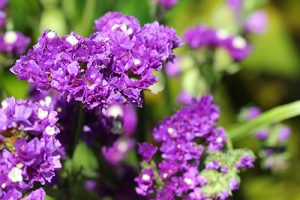
Another common variety of Limonium, itis also called Sea Lavender because it grows wild in salt-marshes. The Greek word Statice means “causing to stand” as the spikes stand fresh-looking for months. Statice displays multiple branches with clusters of tiny funnel-shaped flowers. Each “winged” stem has thin, sword-like leaves of dark green. The papery flowers of Statice come in a wide array of colours including: blue, violet, white, yellow, apricot, salmon, pink, rose and lavender. Statice’s versatility and hardiness make it an ideal staple for every floral outlet. When flower food is used, Statice can last up to 14 days.
Design Suggestions: Statice mixes well with most flowers – especially Pompons, Mini Carnations and Carnations. Use as a filler flower to enhance bouquets of pastel colours. It’s variety of colours makes Statice suitable for both holiday and everyday bouquets and arrangements. Statice is easy to dry; simply hang upside down for several days. Dried, it retains its colour and can be used to enhance potted plants and dried arrangements.
Stock
Species Name: Matthiola incana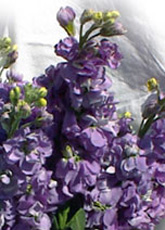
With all the natural charm of an English country garden, the bountiful blooms of Stock have an enticing spicy-sweet fragrance. Double or single flower spikes are surrounded by slender silver-green foliage and hold a mass of brightly coloured blossoms in white, cream, pale peach, lavender, rosy magenta and deep violet. The vase life is approximately 6 – 7 days.
Design Suggestions: Single-stem Stock is excellent in bouquets. Mix with other “garden-type” flowers like Roses, Iris, Lilies and Pompons. Try using in a monochromatic (one colour) theme with Roses, Pompons, Liatris, Statice, etc.
Tulips
Species Name: Tulipa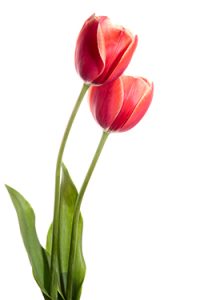
Named because it resembled the colourful Turkish tulband (turban). The word was later corrupted to tulipan, and much later abbreviated to tulip. Tulips originated in a broad area ranging from the Mediterranean to China and were introduced in The Netherlands in the late 1500s. They were once known as “Pot of Gold” because of their high cost. This goblet-shaped bloom is Holland’s most popular flower. Plants have broad leaves with flowers usually borne singly atop long, straight stems. Tulips can increase in size from 1/2 – 1″ after being cut at the farm. There are literally thousands of cultivars with various shapes and colours, including multi-colour and bi-colour varieties. Both stem length and size of bloom vary by variety, and flowers have a vase-life of 7 – 10 days. Tulips can be grouped into four general categories, according to the shape of the flower:
1. single Tulips with rounded petals
2. double Tulips with rounded petals
3. parrot Tulips with fringed petals
4. lily- flowered Tulips with pointed petals

